Apple relies heavily on caffeine. A recent company job listing advertised a role for an iCup technician, with the important task of providing “a fresh brew coffee to all Apple employees within their department.”
Jony Ive’s design team is especially obsessed with the black stuff: For years they kept a $3,000-plus Italian Grimac espresso machine, despite the fact that it leaked all the time. For a while in the 1990s, the design team was even mockingly dubbed “Espresso” for their unabashed love of caffeine culture.
Apple’s not alone in its coffee snob behavior. The rise of coffee shops — with seemingly hundreds of variations on the old coffee standards — have infiltrated every city across the United States: Americans spend $18 billion per year on specialty coffee alone.
But how much do we actually know about it?
Quantified-fitness company Jawbone recently launched an app to find out. Called UP Coffee, the free app lets you track exactly how much caffeine you consume — not only in coffee itself, but also in soda, medications and a variety of foods.
The app’s home screen features a large beaker that fills up with beads as you log more and more caffeine-containing items.
 “The project started because we happened to be looking at which food items were logged the most often in our food system,” says Bandar Antabi, head of special projects at Jawbone. “To our surprise, coffee was the most-logged item across the board. That made it seem more than app-worthy to us.”
“The project started because we happened to be looking at which food items were logged the most often in our food system,” says Bandar Antabi, head of special projects at Jawbone. “To our surprise, coffee was the most-logged item across the board. That made it seem more than app-worthy to us.”
What interested Antabi was that, like many people, he knew surprisingly little about caffeine and how it affected him and his team. When he found out, he was blown away.
“My mom used to drink decaffeinated cappuccino every time we went out to dinner as a family,” he says. “After we’d done all the research for this project, I went back to her and asked, ‘Do you know that a decaf coffee has just as much caffeine as half a can of Coke?’ She had no idea — but the reality is that there’s anything between 9 and 15 milligrams of caffeine in a regular cup of decaf. People just don’t typically know that.”
The Jawbone team members are far from the first people to ever think about measuring how many cups of coffee people consume, but what makes them uniquely positioned to do this is their ability to cross-reference this data with other points of interest, to draw larger macro trends about the role caffeine plays in our lives. The associated Jawbone UP fitness band, for example, tracks sleep patterns, to tell you how many hours (and what quality) of shuteye you get on a regular basis.
UP Coffee can measure your caffeine intake and directly pair this with your sleep data. We might know we can’t drink coffee after 6 p.m. without it keeping us up at night, for example, but how many of us are really able to quantify this observation?
“We can tell you exactly how the amount of coffee you consume each day impacts on the hours and minutes of sleep you get each night.”
“We can tell you exactly how the amount of coffee you consume each day impacts on the hours and minutes of sleep you get each night,” Antabi says.
You may never have stopped to think that the coffee you’re going to drink after dinner could make you lazier the next day but, like Freakonomics, Jawbone can bring all kinds of weird correlations to the surface. Take, for example, the data that indicates that female users (and, while this could be true for men as well, Antabi specifically points to females) typically burn more calories and take more steps the day after they’ve had a good night’s sleep.
“We noticed that in the case of some users, going to bed just one hour past their bedtime average would lead to them losing 1,000 steps the next day,” he says. “Where else would you get this kind of information? It’s all because we’re able to correlate that data, and call people to action.”

The app can also advise on how long it takes caffeine to leave your system, thereby quantifying the absolute latest time you can can safely drink coffee prior to going to bed. This information doesn’t have to be limited to simple number, either. For more visually minded users, it’s easy to display the data as a bar chart or other type of graph.
“We’re not saying that coffee is bad for you,” Antabi says. “In fact, there are quite a few insights that we share about the positive role caffeine can play in your life. It’s more about letting people know just how caffeine affects them, so they can better adjust their behavior, and then maintain that behavior over the long term.”
This idea of modifying user behavior through technology can be seen everywhere, and is often referred to as “nudges.” These nudges can take various forms. One famous example involved a fake housefly that was placed in urinals at Schiphol Amsterdam Airport. By giving urinating men something to aim at, spillage was reduced by a whopping 80 percent.
In a crowded marketplace, Jawbone thinks that nudges are the way to stand apart, since they provide some much-needed actionable context. “There are plenty of other activity trackers out there that will tell you how many steps you’ve taken in a particular day, or how many hours of sleep they’ve had in a given night,” Antabi says. “But then what? The future of this industry is going to be about explaining this data, in a way that will drive positive behavior change. If they don’t do this, they won’t engage the user, and what you’ll see is that after 90 days people will simply stop using them.”
“There’s no reason why we wouldn’t look at putting our software on [the iWatch].”
This brings up the question of Apple and its long-awaited iWatch. Interestingly, Apple recently updated its iOS 8 Health app to add the familiar-sounding feature of caffeine measurement. While Antabi hasn’t yet used Apple’s caffeine app — and therefore can’t compare it to UP Coffee — he did share some interesting insights regarding how a company such as Jawbone is approaching the possibility of being squeezed by an Apple fitness band.
“Obviously we have our hardware right now, but there’s no reason why we wouldn’t look at putting our software on other platforms if we felt like this was something that could be advantageous,” he says. “It’s too early to speculate on what Apple’s going to do in the smartwatch space, but there’s no reason why we wouldn’t be able to shift the UP platform to work on the iWatch, or whatever they opt to call it in the end.”
If Apple does come to dominate the space — and then opens it up to developers, as happened with the iPhone and its App Store — Antabi is convinced Jawbone could still flourish.
“If you look at the quality of the work we’re doing with applications like UP Coffee, we have a lot of expertise — and a great software team — that could help us make that transition,” he says. “It’s definitely something we’re looking into.”


